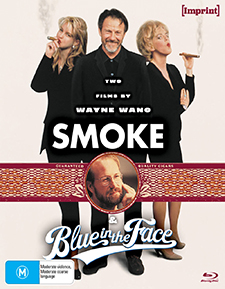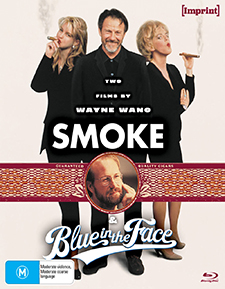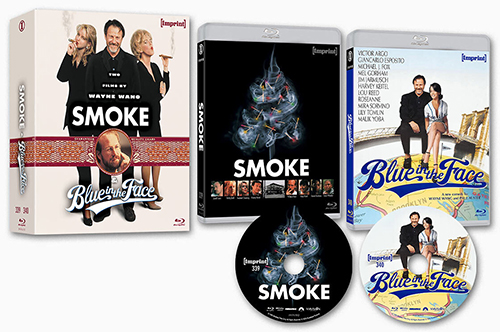Smoke/Blue in the Face (Blu-ray Review)

Director
Wayne Wang, Paul AusterRelease Date(s)
1995 (July 31, 2024)Studio(s)
Mirimax Films (Imprint Films/Via Vision Entertainment)- Film/Program Grade: See Below
- Video Grade: See Below
- Audio Grade: See Below
- Extras Grade: A-
- Overall Grade: A-
Review
[Editor’s Note: This is a Region-Free Australian Blu-ray import.]
Wayne Wang made a name for himself directing low-key slice of life films like Chan Is Missing, Dim Sum: A Little Bit of Heart, and Eat a Bowl of Tea, but his career looked like it might take a different turn after the success of his luminous adaptation of Amy Tan’s The Joy Luck Club. It felt like a natural progression from his previous work, but it was still a progression into a different scale of storytelling. Yet quietly, in the background, he had already started to work with author Paul Auster on developing the script for another low-key slice of life drama set in and around a Brooklyn tobacco shop: Smoke. Their partnership was so fruitful that they hatched the idea for a spinoff called Blue in the Face while they were still filming Smoke, and they managed to turn it around in a few days using the same sets and some of the same actors. While the two films share the same DNA, each of them takes a drastically different approach in terms of the actual filmmaking: Smoke was carefully planned and scripted, while Blue in the Face was largely improvised on the fly.
Paul Auster’s script for Smoke entangles the lives of several different characters who live in Brooklyn, with the point of intersection between all of them being the Brooklyn Cigar Co. run by Auggie Wren (Harvey Keitel). Everyone in the film ends up connected to the tobacco shop in one form or another, either as patrons, employees, or those who end up affected by the patrons or employees. In other words, Smoke is really about community. It involves family in all of its forms, both natural and extended, and it demonstrates the way that neighborhoods can revolve around familiar locations that become a staple part of resident’s lives. The other key characters in the film include Paul Benjamin (William Hurt), an author who serves as a thinly-veiled stand in for Auster, and Rashid (Harold Perrineau), a drifter whose travails throughout the neighborhood ends up affecting everyone else involved.
That’s barely scratching the surface of the extended family in Smoke, however. There’s also the shop’s owner Vinnie (Victor Argo); the mentally disabled janitor (Jared Harris); Auggie’s ex-girlfriend Ruby (Stockard Channing); a troubled young woman who may or may not be Auggie’s daughter (Ashley Judd); a local gangster (Malik Yoba); Augie’s current girlfriend Violet (Mel Gorham), a nearby garage owner connected to Rashid (Forest Whitaker); and a few of the regulars at the shop (Giancarlo Esposito, José Zúñiga, and Stephen Gevedon). And that’s still just a taste of all the myriad characters whose lives are touched by the events that revolve around the Brooklyn Cigar Co. over the span of a few short days.
Despite a handful of major reveals, Smoke isn’t about the big moments, but rather about the small workaday ones. Auster and Wang’s goal was to create the equivalent of a Yasujirō Ozu film set in Brooklyn, so everything unfolds at a leisurely pace in lengthy takes. Smoke involves the erratic rhythms of real life rather than the cinematic rhythms of conventional dramas. Of course, for classical film critics and theorists like André Bazin and Siegfried Kracauer, reproducing the natural rhythms of life was inherently cinematic—Kracauer even subtitled his book on film theory The Redemption of Physical Reality. The only artificiality that Smoke embraces is the entirely naturalistic ones that are inherent to the human experience. People’s lives are filled with artificiality of their own creation. Auster has said that in Smoke, stealing is a form of giving, and lying is a form of truth-telling. Smoke is cinematic storytelling that embraces the storytelling that people use to get through life on their own terms.
The creative process for Smoke took place over several years while Wang and Auster hashed out the details, and nearly every last word of dialogue in the film was carefully scripted in advance. That’s in sharp contrast with Blue in the Face, which they conceived of while shooting Smoke and threw together over the span of a few days. Wang and Auster still contributed their own ideas, along with documentarian Harvey Wang (who shot the video segments that are interspersed throughout the film), but those ideas mostly involved creating situations, setting up the cameras, and letting the actors improvise the actual scenes. That necessitated completely different rhythms than the ones in Smoke, since improvisation leaves less room for space between the words—as soon as one actor pauses, another one usually jumps in. The threads between the characters are also less connected this time around; it’s less of chronicle of their lives than it is a paean to Brooklyn itself.
Many of the actors from Smoke returned for Blue in the Face, including Harvey Keitel, Victor Argo, Malik Yoba, Mel Gorham, Jared Harris, Giancarlo Esposito, José Zúñiga, and Stephen Gevedon. This time around, they were joined by an eclectic group that includes Lou Reed, Michael J. Fox, Jim Jarmusch, Madonna, Roseanne Barr, Keith David (as the ghost of Jackie Robinson!), Mira Sorvino, Lily Tomlin, Michael Badalucco, and RuPaul (because of course). John Lurie and his band The John Lurie National Orchestra also make an appearance. As a result, Blue in the Face has an easygoing charm that’s quite different than Smoke—I mean, it features Victor Argo singing a couple of songs while playing the guitar, and how more easygoing can you get than that? Yet however rambling and discursive that Blue in the Face may seem, the same sense of community from Smoke still shines throughout it. Both films serve as a poignant reminder that true families aren’t born, they’re made. That’s a message that never goes out of style.
Cinematographer Adam Holender shot Smoke on 35mm film using Panavision cameras with spherical lenses, framed at 1.85:1 for its theatrical release. There’s no information available about this HD master, but it appears to be an older one that has the characteristic look of early Mirimax Blu-rays. Grain is minimized, though not completely erased, and there’s a slightly processed digital look to much of the film. That said, it’s not consistent, and some of the closeups look quite good, especially the final ones on William Hurt and Harvey Keitel during the Christmas story. Other shots look a bit more scrubbed and lacking in fine detail. Despite that, there’s also some light speckling throughout. The colors and contrast are both fine, however.
Adam Holender also shot Blue in the Face on 35mm film using Panavision cameras with spherical lenses, although his work was supplemented by the video segments that were shot by Harvey Wang (no relation to Wayne). The SD video footage was scanned out to film and cut in with the rest of the material, with everything framed at 1.85:1 for its theatrical release. This master might be even older, and either it’s 480p that’s been upscaled to 1080p, or else it’s a 1080p master that’s been filtered so heavily that it’s hard to tell the difference. Aside from Harvey Wang’s footage, it still looks like film, but everything is soft enough that it’s hard to read some of the text on signs at the back of the store. There’s still speckling visible, and there’s also some instability and frame jumps at a few points throughout the film.
Audio for Smoke is offered in English 5.1 DTS-HD Master Audio and 2.0 LPCM, with optional English SDH subtitles. Smoke was originally released in Dolby Stereo, and this 5.1 mix sounds like a relatively straightforward discrete encoding of that matrix-encoded four channel mix. It definitely has the edge over the 2.0 version. It’s a solid track, with consistent immersion from the sounds of the city streets and the countryside locations. The score from Rachel Portman and the various pieces of source music really benefit from the 5.1 treatment.
Audio for Blue in the Face is offered in English 2.0 LPCM only, with optional English SDH subtitles. Blue in the Face was also released in Dolby Stereo, but in this case it’s largely a mono mix with stereo music. The dialogue and effects remain firmly anchored to the center channel, and while the music does benefit from having a stereo spread, it lacks the dynamic punch of the music in Smoke.
SMOKE (FILM/VIDEO/AUDIO): B+/B/B+
BLUE IN THE FACE (FILM/VIDEO/AUDIO): B-/C/B-
Via Vision’s Region-Free Limited Edition Blu-ray release of Smoke and Blue in the Face is #339 and #340 in their Imprint Films line. It’s a two-disc set that includes each film on a separate disc housed in its own clear Amaray case, with the theatrical poster artwork on one side of the insert and scenes from the film visible on the other sides when the cases are opened. (Smoke uses a less familiar alternate Japanese poster design, but it’s still theatrical artwork.) Everything comes housed in one of Imprint’s rigid Hardboxes that opens up at the top. The following new and archival extras are included:
DISC ONE: SMOKE
- Audio Commentary by Paul Auster, Peter Newman, Greg Johnson, and Harvey Keitel
- 16 Going on 30 (HD – 20:30)
- Splicing Smoke (HD – 22:28)
- Running Off to the Circus: Paul Aster on Film (HD – 103:17)
- Building Brooklyn Cigar Company (HD – 20:38)
- Auggie’s Corner (HD – 12:41)
- 1995 Berlin International Film Festival Press Conference (SD – 43:41)
- Deleted Scenes (Upscaled SD – 8:05, 2 in all)
- Behind-the Scenes (Upscaled SD – 20:50)
- Making of (Upscaled SD – 5:41)
- Theatrical Trailer (Upscaled SD – 2:11)
The commentary mixes Paul Auster and Harvey Keitel with producers Peter Newman and Greg Johnson, and it was originally recorded for the 2003 DVD release of Smoke from Mirimax. (Keitel was recorded separately and edited in with the others.) They recount the circuitous path that Smoke took to reach the screen, starting with the original Christmas story that the New York Times commissioned Auster to write back in 1990, and how it got expanded into a feature film idea over the next few years. That required some lengthy back-and-froth between Auster and Wayne Wang, but it was enough that Wang decided to split his possessory credit with Auster, something that became a major bone of contention with the DGA. (Robert Altman also made some suggestions that they ended up using in the final film.) They explain that the title Smoke doesn’t just refer to the physical act of smoking, but it also serves as a metaphor about the ephemeral nature of the connections between people. It’s about lost children and how extended families form, with everyone ultimately having to learn how to get along with each other. They also explain when the idea for Blue in the Face occurred to them during the filming of Smoke.
Via Vision has added some new extras, all of which are interviews with the cast and crew. 16 Going on 30 is with Harold Perrineau, who offers some thoughts about the craft of acting and how his experiences led him to the role of Rashid. Splicing Smoke is with editor Masie Hoy, who talks about her own background with Robert Altman and the complex process of piecing together Smoke. Building Brooklyn Cigar Company is with production designer Kalina Ivanov, who shows some of her drawings and compares them to the final sets. She also talks about how Blue in the Face happened.
The centerpiece of all the new extras is Running Off to the Circus, a feature-length interview with Paul Auster. It’s a comprehensive look at his entire life and career, including the influence that the cinema had on him as a child, as well as his work as an author, screenwriter, and director. It’s divided into two parts, with the first half covering his thoughts on film in general, and the second half focusing on his own work.
Via Vision have also added a few archival extras that haven’t been included in previous releases of Smoke. The first one consists of archival footage from the 1995 Berlin International Film Festival Press Conference. It’s a Q&A that included Wayne Wang, Paul Auster, Havey Keitel, William Hurt, Gregg Johnson, Peter Newman, and co-producer Hisami Kuroiwa. Auggie’s Corner is a Q&A conversation between Wayne Wang and Robert Fischer that was recorded at the Hof Film Festival in Germany back in 2007.
The rest of the extras are all from the previous DVD and Blu-ray releases of Smoke. There’s a collection of two different Deleted Scenes, one including Andrew McCarthy visiting the shop, and the other a dinner date at a Chinese restaurant. The Behind-the-Scenes and Making Of featurettes cover the conception and production of Smoke, featuring on-set and promotional interviews with Paul Auster, Wayne Wang, William Hurt, Harvey Keitel, Stockard Channing, Forest Whitaker, Ashley Judd, Harold Perrineau, and Adam Holender.
DISC TWO: BLUE IN THE FACE
- Audio Commentary by Wayne Wang, Paul Auster, Peter Newman, Greg Johnson, and Harvey Keitel
- Can’t Stop Don’t Think (HD – 22:48)
- Spine, Threads and Textures (HD – 15:25)
- Two Films for the Price of One Set (HD – 12:00)
- A Conversation with Lou Reed (Upscaled SD – 18:11)
- Interview with Mel Gorham (Upscaled SD – 8:38)
- OTB Boys – Outtakes (Upscaled SD – 33:30, 4 in all)
- Theatrical Trailer (HD – 1:26)
This time around, Wayne Wang joins Auster, Newman, and Johnson (once again, Harvey Keitel was recorded separately). This commentary was recorded for the 2003 DVD release of Blue in the Face from Mirimax. They recount the process that led to them making this spinoff, including their original plans that didn’t work out as well as they hoped, so they ended up restructuring the film during the editorial process. They offer some glimpses of the different forms of improv that the actors used, like how Jim Jarmusch had worked out a list of ideas that the posted off-camera that he could choose from while shooting. Lou Reed, on the other hand, never lacked for anything to say, so they had to restructure his rambling narratives during the edit. Everyone involved contributed ideas to the final film, including Auster’s wife. Auster says that he always felt that Smoke was a nicely prepared meal, while Blue in the Face was a sweet and crazy desert.
Via Vision has also added a collection of new interviews for this release of Blue in the Face. Can’t Stop Don’t Think is with Jared Harris, who discusses the challenging nature of improvised films and where Smoke and Blue in the Face fell in his life and career. Spine, Threads and Textures is with editor Christopher Tellefsen, who traces the complex process of assembling Blue in the Face, including putting together the music. (He also talks about recutting Smoke after Masie Hoy was unavailable.) Two Films for the Price of One Set is with line producer Diana Phillips (yes, there were a lot of producers on both of these films). She explains how she brought her own experiences to bear in overcoming the challenges of producing both of these films in a short period of time.
The rest of the extras are all archival ones. A Conversation with Lou Reed is an extended version of Reed’s improvised storytelling. Auster can be heard in the background prodding him with questions. It’s interesting to compare this lengthy monologue with the way that it’s broken up in the final film. The Interview with Mel Gorham looks like it was conducted for a Texas television station while Gorham was on tour promoting Blue in the Face. She talks about her small scripted role in Smoke was expanded for the follow-up. Finally, OTB Boys – Outtakes is a collection of a few extended improvs with the regulars at the Brooklyn Cigar Co. (including another performance by the John Lurie National Orchestra).
Via Vision deserves full props for assembling such an impressive collection of extras for this set. It’s nearly everything significant from previous releases, plus a hefty collection of new ones. While it would have been nice to get some fresh scans of better elements, especially in the case of Smoke, that wasn’t an option given the murky state of the Mirimax catalogue right now. Sometimes, you have to play the cards that you’re dealt, and Via Vision did the best that they could here. It’s still fantastic to have these two neglected films collected together in such a lovely set. It’s highly recommended, with minor caveats.
- Stephen Bjork
(You can follow Stephen on social media at these links: Twitter, Facebook, and Letterboxd).


